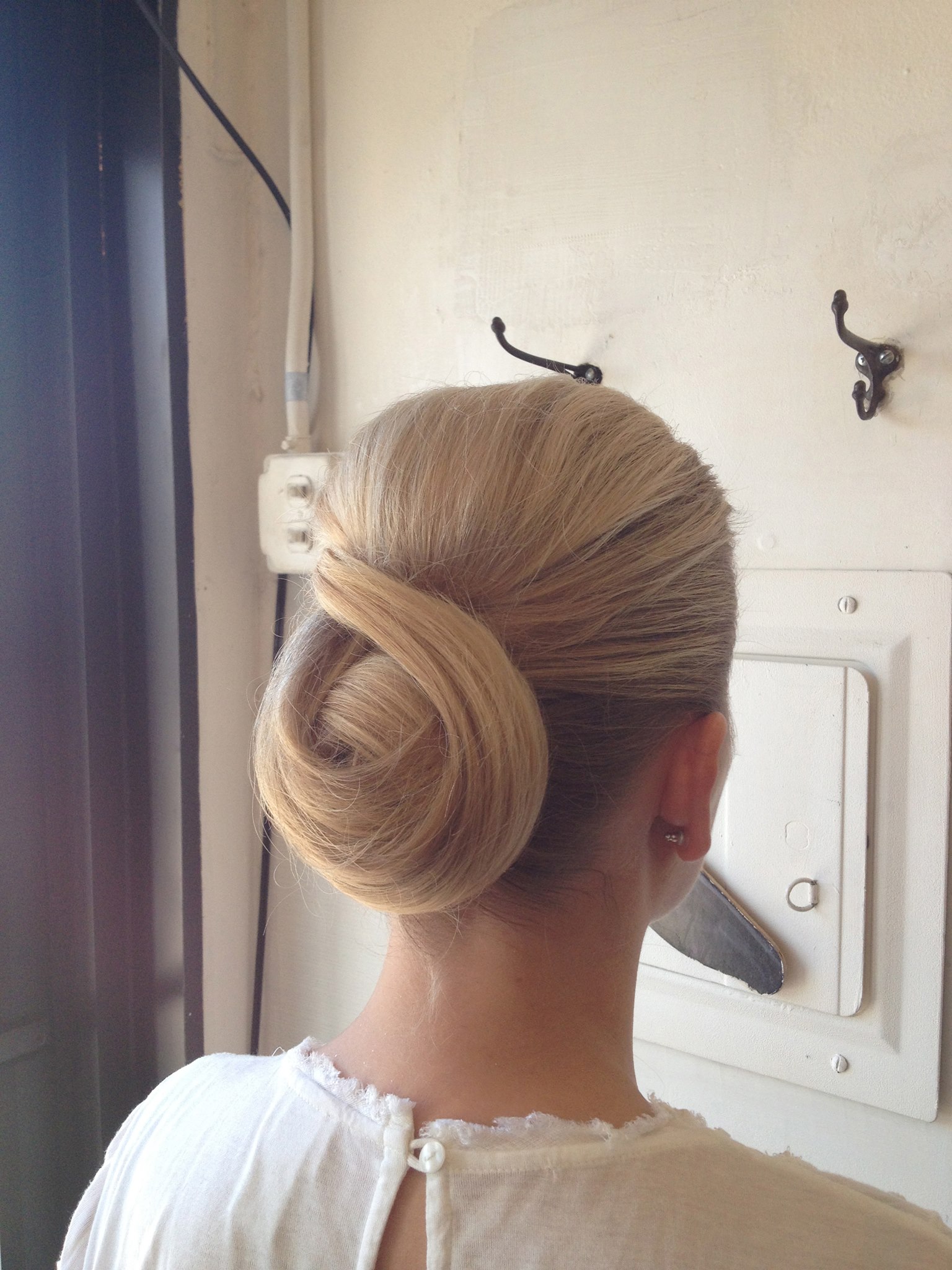Chignon (hairstyle) on:
[Wikipedia]
[Google]
[Amazon]
 A chignon (, , ) is a popular type of hairstyle. The word "chignon" comes from the French phrase ''chignon du cou'', which means
A chignon (, , ) is a popular type of hairstyle. The word "chignon" comes from the French phrase ''chignon du cou'', which means
"History of Hair"
2004. UKHairdressers. Accessed 29 April 2007. * *
nape
The nape is the back of the neck. In technical anatomical/medical terminology, the nape is also called the nucha (from the Medieval Latin rendering of the Arabic , "spinal marrow"). The corresponding adjective is ''nuchal'', as in the term ''nu ...
of the neck.
Chignons are generally achieved by pinning the hair into a knot at the nape of the neck or at the back of the head, but there are many variations of the style. They are usually secured with accessories such as barrette
A barrette (American English), also known as a hair slide (British English), or a hair clip, is a clasp for holding hair in place. They are often made from metal or plastic and sometimes feature decorative fabric. In one type of barrette, a cla ...
s or hairpin
A hairpin or hair pin is a long device used to hold a person's hair in place. It may be used simply to secure long hair out of the way for convenience or as part of an elaborate hairstyle or coiffure. The earliest evidence for dressing the hai ...
s. Chignons are frequently worn for special occasions, like weddings and formal dances, but the basic chignon is also worn for everyday casual wear.
History
The chignon can be traced back toancient Greece
Ancient Greece ( el, ß╝Ö╬╗╬╗╬¼Žé, Hell├Īs) was a northeastern Mediterranean Sea, Mediterranean civilization, existing from the Greek Dark Ages of the 12thŌĆō9th centuries BC to the end of Classical Antiquity, classical antiquity ( AD 600), th ...
, where Athenian
Athens ( ; el, ╬æ╬Ė╬«╬Į╬▒, Ath├Łna ; grc, ß╝ł╬Ėß┐å╬Į╬▒╬╣, Ath├¬nai (pl.) ) is both the capital and largest city of Greece. With a population close to four million, it is also the seventh largest city in the European Union. Athens dominates ...
women commonly wore the style with gold or ivory handcrafted hairpins. Athenian men wore the style as well, but they fastened their chignons with a clasp of "golden grasshoppers", according to ''The History of the Peloponnesian War
The ''History of the Peloponnesian War'' is a historical account of the Peloponnesian War (431ŌĆō404 BC), which was fought between the Peloponnesian League (led by Sparta) and the Delian League (led by Athens). It was written by Thucydides, a ...
'', by Thucydides
Thucydides (; grc, , }; BC) was an Athenian historian and general. His '' History of the Peloponnesian War'' recounts the fifth-century BC war between Sparta and Athens until the year 411 BC. Thucydides has been dubbed the father of " scienti ...
. The chignon was specific to Athens
Athens ( ; el, ╬æ╬Ė╬«╬Į╬▒, Ath├Łna ; grc, ß╝ł╬Ėß┐å╬Į╬▒╬╣, Ath├¬nai (pl.) ) is both the capital and largest city of Greece. With a population close to four million, it is also the seventh largest city in the European Union. Athens dominates ...
, as other city states, such as Cyprus
Cyprus ; tr, K─▒br─▒s (), officially the Republic of Cyprus,, , lit: Republic of Cyprus is an island country located south of the Anatolian Peninsula in the eastern Mediterranean Sea. Its continental position is disputed; while it is ge ...
and Sparta
Sparta ( Doric Greek: ╬ŻŽĆ╬¼ŽüŽä╬▒, ''Sp├Īrt─ü''; Attic Greek: ╬ŻŽĆ╬¼ŽüŽä╬Ę, ''Sp├Īrt─ō'') was a prominent city-state in Laconia, in ancient Greece. In antiquity, the city-state was known as Lacedaemon (, ), while the name Sparta referre ...
, had their own styles of hairdressing. The chignon was also popular in ancient China, where married women wore the low, knotted hairstyle.
Male writers of the Victorian era
In the history of the United Kingdom and the British Empire, the Victorian era was the period of Queen Victoria's reign, from 20 June 1837 until her death on 22 January 1901. The era followed the Georgian period and preceded the Edwardia ...
, like Anthony Trollope, were fond of poking fun at the perceived absurdity of the fashion, which was much in vogue in England
England is a country that is part of the United Kingdom. It shares land borders with Wales to its west and Scotland to its north. The Irish Sea lies northwest and the Celtic Sea to the southwest. It is separated from continental Europe b ...
in the 1860s. In the 1890s, the dancer Cl├®o de M├®rode
Cl├®op├ótre-Diane de M├®rode (27 September 1875 ŌĆō 17 October 1966) was a French dancer of the Belle ├ēpoque. She has been referred to as the "first real celebrity icon" and the "first modern celebrity". She was also the first woman whose photo ...
popularized the hairstyle in France
France (), officially the French Republic ( ), is a country primarily located in Western Europe. It also comprises of overseas regions and territories in the Americas and the Atlantic, Pacific and Indian Oceans. Its metropolitan area ...
.
See also
*Bun
A bun is a type of bread roll, typically filled with savory fillings (for example hamburger). A bun may also refer to a sweet cake in certain parts of the world. Though they come in many shapes and sizes, buns are most commonly round, and are g ...
* Cockernonnie
A cockernonnie or cockernonie was an old Scottish women's hairstyle. It was a gathering up of the hair, after a fashion similar to the modern '' chignon'', and sometimes called a "cock-up". Mr. Kirkton of Edinburgh, preaching against "cock-ups" Ō ...
References
Bibliography
* * *"History of Hair"
2004. UKHairdressers. Accessed 29 April 2007. * *
External links
* {{Human hair 19th-century fashion Hairstyles